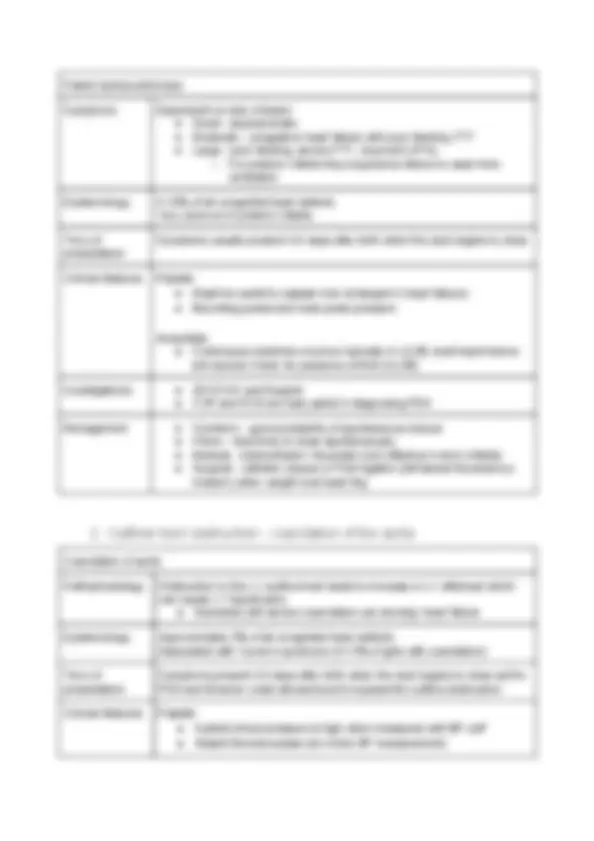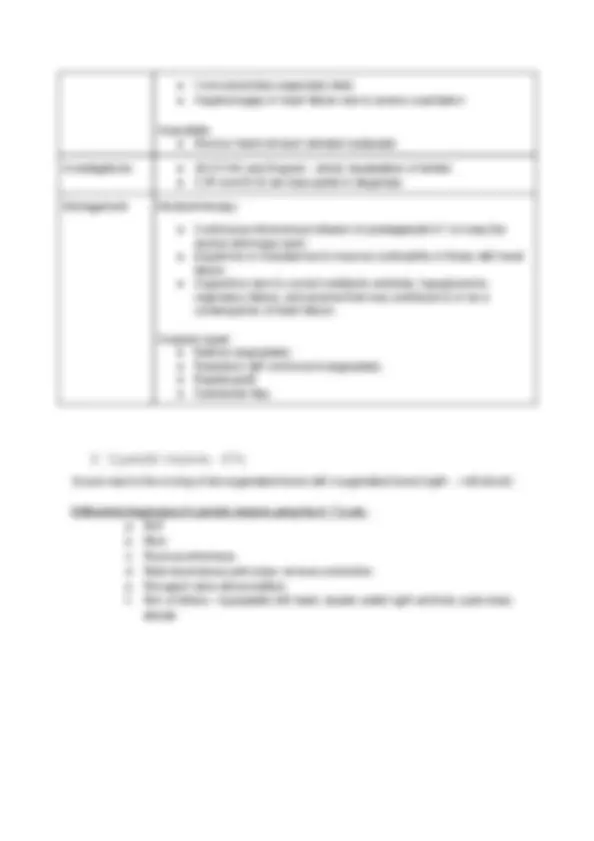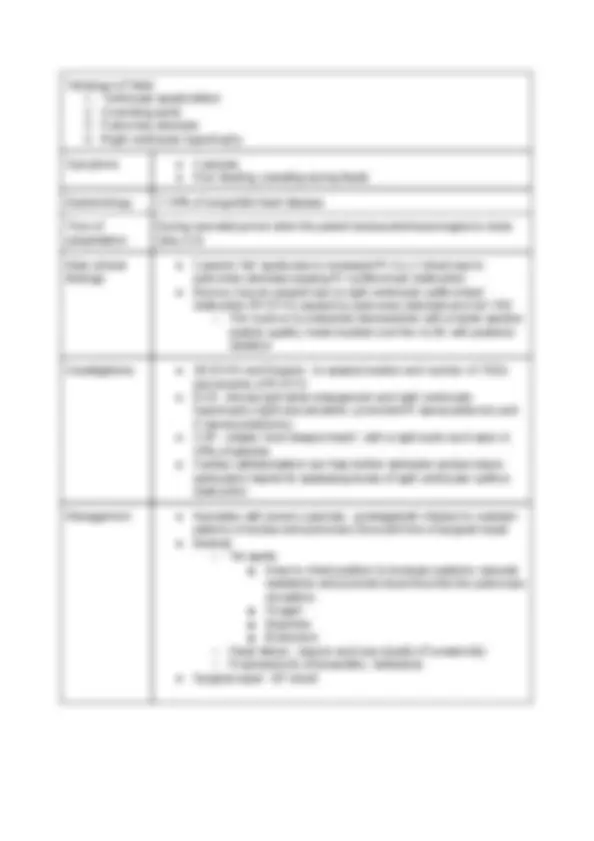





Study with the several resources on Docsity

Earn points by helping other students or get them with a premium plan


Prepare for your exams
Study with the several resources on Docsity

Earn points to download
Earn points by helping other students or get them with a premium plan
Community
Ask the community for help and clear up your study doubts
Discover the best universities in your country according to Docsity users
Free resources
Download our free guides on studying techniques, anxiety management strategies, and thesis advice from Docsity tutors
CXR - cardiomegaly and pulmonary odema (increased pulmonary vascular markings) if severe VSD (presence of heart failure), enlarged pulmonary artery.
Typology: Lecture notes
1 / 6

This page cannot be seen from the preview
Don't miss anything!




● Left to right shunting, mixing of oxygenated blood with deoxygenated blood ● Increased pulmonary blood flow → risk of pulmonary hypertension and untreated acyanotic heart disease can lead to Eisenmenger syndrome ● Lesions that are above the level of the nipple usually give rise to ejection systolic murmurs while lesions below the level of the nipple typically cause pan systolic murmurs
Ventricular septal defect
Symptoms Depends on size of defect ● Small - may be asymptomatic, normal growth ● Moderate - poor feeding, FTT, SOB ● Large - poor feeding, FTT (falls below centiles), SOB, sweaty and pale with feeds
Epidemiology Most common congenital heart lesion (15-20%) Associated with Down’s syndrome (AVSD)
Time of presentation
Antenatal diagnosis at 16-18 weeks Presentation at 6-8 weeks Congestive heart failure typically presents after 4-6 weeks Persistent pulmonary hypertension of the newborn (PPHN) may become established by 6-12 months
Clinical findings Palpate
● Check for presence of thrill ● Might be useful to palpate liver (enlarged in heart failure) Auscultate ● Loudness of murmur is inversely proportionate to the size of defect ● Pan-systolic murmur heard loudest at LLSB ● Typically grade 3- ● Loud P2 suggests presence of pulmonary hypertension
Investigations ● Pulse oximetry to determine level of oxygen saturation ● ECHO - visualise defect directly ● CXR - cardiomegaly and pulmonary odema (increased pulmonary vascular markings) if severe VSD (presence of heart failure), enlarged pulmonary artery ● ECG - ○ In patients with moderate or large VSD, the ECG may demonstrate LV hypertrophy (LVH) manifested as increased voltage in V5 and V6, or leads II, III, and aVF ○ In patients with elevated RV pressure, the ECG demonstrates RV hypertrophy (RVH), often manifested by tall R waves in
leads V4R and V1, or upright T waves in these leads beyond the first 24 hours of life, in addition to LVH.
Management ● Small lesion < 5mm usually close spontaneously, no repair required (30-40%) ● Moderate lesion ○ Diuretic therapy (Furosemide and Spironolactone) ○ Feeding with high caloric feeds (Infantrini) ● Large lesion ○ Manage as per moderate lesion ○ Optimise weight gain for surgery ○ Schedule for surgery before 12 months to prevent PPHN
Atrial septal defect
Symptoms ● Typically asymptomatic ● Some children will have recurrent chest infections
Epidemiology Second most common acyanotic heart lesion (5-10%)
Time of presentation
Mean age of diagnosis is 4.5 years from incidental finding of murmur Symptomatic presentation is usually before age of 40 years with arrhythmias, dyspnoea
Clinical features ● May also have no auscultatory finding in infants (asymptomatic) Auscultate ● Ejection systolic murmur heard loudest at ULSB ● Widely fixed splitting of second heart sound (L→ R shunting increases RV filling, thus RV ejection time is increased and pulmonary valve closure is delayed for a significant amount of time after aortic valve closure)
Investigations ● Pulse oximetry ● ECHO - visualise defect directly, shows dilated RV and increased RV filling and ejection time ● CXR - usually no findings ● ECG - incomplete RBBB
Management ● Most children asymptomatic and rarely require CHF therapy ● Spontaneous closure in lesions smaller than 7-8mm ● Large defects require repair - percutaneous (catheter closure) or surgery using median sternotomy incision
● Cold extremities (especially feet) ● Hepatomegaly in heart failure due to severe coarctation
Auscultate ● Murmur heard at back between scalpulae
Investigations ● 2D ECHO and Doppler - direct visualisation of defect ● CXR and ECG are less useful in diagnosis
Management Medical therapy:
● Continuous intravenous infusion of prostaglandin E1 to keep the ductus arteriosus open ● Dopamine or Dobutamine to improve contractility in those with heart failure ● Supportive care to correct metabolic acidosis, hypoglycemia, respiratory failure, and anemia that may contribute to or be a consequence of heart failure.
Surgical repair: ● Balloon angioplasty ● Resection with end-to-end angioplasty ● Bypass graft ● Subclavian flap
Occurs due to the mixing of deoxygenated blood with oxygenated blood (right → left shunt)
Differential diagnoses of cyanotic lesions using the 6 ‘T’s are: a. T OF b. T GA c. T runcus arteriosus d. T otal anomalous pulmonary venous connection e. T ricuspid valve abnormalities f. T on of others - hypoplastic left heart, double outlet right ventricle, pulmonary atresia
Tetralogy of Fallot
Symptoms ● Cyanosis ● Poor feeding, sweating during feeds
Epidemiology 7-10% of congenital heart disease
Time of presentation
During neonatal period when the patent ductus arteriosus begins to close (Day 3-5)
Main clinical findings
● Cyanotic “tet” spells due to increased RV to LV shunt due to pulmonary stenosis causing RV outflow tract obstruction ● Murmur may be present due to right ventricular outflow tract obstruction (RVOTO) caused by pulmonary stenosis and not VSD ○ The murmur is crescendo-decrescendo with a harsh ejection systolic quality, heard loudest over the ULSE with posterior radiation
Investigations ● 2D ECHO and Doppler - to assess location and number of VSDs and severity of RVOTO ● ECG - shows right atrial enlargement and right ventricular hypertrophy (right axis deviation, prominent R waves anteriorly and S waves posteriorly) ● CXR - classic “boot shaped heart”, with a right aortic arch seen in 25% of patients ● Cardiac catheterisation can help further delineate cardiac lesion, particularly helpful for assessing levels of right ventricular outflow obstruction.
Management ● Neonates with severe cyanosis - prostaglandin infusion to maintain patency of ductus and pulmonary flow until time of surgical repair ● Medical ○ Tet spells ■ Knee to chest position to increase systemic vascular resistance and promote blood flow into the pulmonary circulation ■ Oxygen ■ Morphine ■ B-blockers ○ Heart failure - digoxin and loop diuretic (Furosemide) ○ Prophylaxis for endocarditis - antibiotics ● Surgical repair - BT shunt